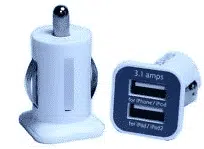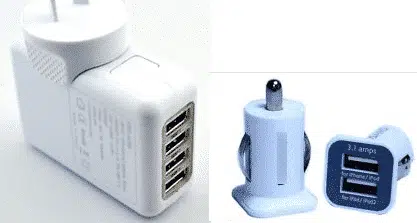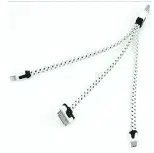We’ve been digging and found something interesting – when charging a device from a USB socket, the CABLE can make a big difference to charging speed. I’ve been having trouble with slow charging of my phone … sometimes the charge can only keep up with use and there’s little improvement in the battery charge.
It turns out not all cables are the same, not by a long shot. There’s plenty of talk about USB sockets, we’ll do it ourselves below, but the wrong cable can slow charging a surprising amount.
Here’s what we’ve found out from our tests and long experience in charging all manner of devices both at home and around the world.
Check the cable
Having a fast charge USB socket isn’t enough. The cable has to be good enough to pass through the available power. A poor cable will cancel out any benefit from the better AC adapter.
A more expensive or branded cable isn’t necessarily better. A longer cable is more likely to reduce power transmission so better to stick with shorter cables (under 1m / 3ft).
But the cable length isn’t the only factor. The quality of the cable can also make a big difference. In our tests, two 1m USB cables gave very different results. (After our tests were done, we found a 2m cable that output some more power than the 1m cables, showing that a shorter cable isn’t always better.)
Doing some simple tests of your own will help find the better combinations of adapter and cable.
Modern iPad’s, despite seemingly accepting USB power, need far more milliamps than a standard USB socket will provide. That’s why iPad users often get frustrated when there’s no ‘charging’ indicator after plugging into a normal USB socket. Apple would like them to think that they need a special and pricey Apple adapter when just a USB socket with more power is enough.
Slow charging off a laptop is OK for smartphones with time to charge, just plug-in overnight and the device should be full in the morning. When travelling a faster charge is very handy. If you have a USB socket in your car, you’ll want a faster charge for topping up your device. Apple iPad users need the higher milliamps to charge their larger battery. Peter carries a car twin socket adapter when travelling to use in rental cars to power both a phone and GPS unit.
Note: some cables can only charge devices, not connect to a computer for data transfer.
About USB sockets
There’s a lot written about USB sockets, power output and a lot of confusion. Some of the confusion lies in the difference between the official USB specifications and what USB sockets are made to do. USB wasn’t originally intended for charging devices and so the official power specifications for USB v1 and v2 were relatively low. Only with USB v3 was the official power output raised from 500mA to 900mA.
That’s just the written specification. Out in the real world, things are a lot different. In response to charging needs, USB sockets have been made which exceed the official power output sometimes by over 400% to 2,100mA. You can find these ‘charging sockets’ on some AC to USB socket adapters or special car adapters for the cigarette lighter socket. Note: not all AC or car adapters offer higher mA, check the label before you buy.
Both the adapters pictured offer high power output. The AC adapter on left is rated for 2,100mA shared across four sockets. The car adapter on right has two sockets sharing an advertised 3,100mA. Both are generic models readily available, especially from various ebay merchants.
We suggest getting AC/Car adapters that have USB sockets (not adapters which are ‘hard-wired’ to a single cable and plug). With USB sockets you can easily switch cables/plugs to suit different devices or a better cable.
To add more complexity, USB hubs can’t output enough power unless they are separately powered (i.e. there’s an AC adapter plugged in, as well as the USB cable to the computer).
Multiple socket charging adapters (like those shown above) reduce power when more devices are plugged in (because the available power is shared across the sockets in use). A set of 2,100mA sockets should be able to charge a large tablet plus a smaller phone at the same time, but the more you plug in, the lower charge that can go to each device. For that reason, 2 or 4 port charging adapters are usually more than enough, we avoid the 6 socket accessories.
Cables
You’d hope that the ‘official’ cables from the device manufacturer are better quality and therefore better power throughput than generic cables. Sadly there’s no guarantee that’s the case.
So called ‘premium’ cables may be better, or it might just be the labeling. There’s no way to be sure until you test the cable yourself.
Tips from the road:
- When buying an AC adapter for your laptop, look for one with a separate USB socket in the power block. This gives you another socket for fast charging another device without carrying yet another accessory.
- If you take a multi-socket AC ‘power board’ when travelling, look for one with some USB sockets as well. Never hurts to have some spare charging outlets.
- Check the specifications for your laptop computer. Some have higher power output from their USB sockets. Others leave a USB socket ‘live’ when the computer is off but plugged into an AC adapter.
- Don’t buy an AC adapter with a hardwired cable and plug to charge a single device. They are usually expensive, the cable breaks too easily and isn’t flexible. In addition, the power rating on the adapter might not be what is output from the plug since the cable quality isn’t known.
- Better to buy an AC adapter with 2 or 4 USB sockets (high power) plus separate cables. If the cables break, they are cheap to replace. You can share your sockets with others or change to different devices quite easily.
- With any AC adapter make sure it’s compatible with a wide range of voltages for travelling. Most adapters sold are 110v – 250v auto-switching, but some 110v only models are out there.
- If you have a mix of Apple and Android devices, or have ‘mixed device’ associates, consider a ‘three in one’ or ‘3 in 1’ cable. These short cables have the common microUSB plug plus both the old and new ‘Lightening’ plugs for Apple devices. They are easy and cheap to buy off ebay.
- Some airplane seats offer USB sockets that are promoted for using your own memory stick to play music or videos on the seat back screen. Instead use the socket to charge your device. The power output from the seat socket will be low (probably around 450mA) but it’s better than nothing. At worst, on a large device, your battery will drain more slowly.


